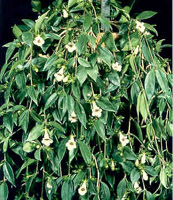
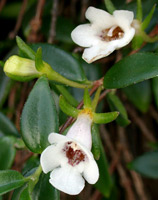
Left: Cult. Cornell University, phot. M.H. Stone
Right: Plant of the week, Smithsonian Institution,
phot. L. Brothers, http://persoon.si.edu/plofweek.index.cfm
Full name and orig. publication: Codonanthe (Mart.) Hanst., Linnaea 26: 209 (April 1854, "1853"), nom. cons.
Etymology: Derived from the Greek κωδων, kōdōn = bell, and άνθη, anthē = flower, referring to the (sub)campanulate corolla form.
Synonyms: Hypocyrta sect. Codonanthe Mart. (1829), Coccanthera C.Koch & Hanst. (1855).
Infrafamilial position: Gesnerioid Gesneriaceae (Gesnerioideae) - Episcieae.
Description: Epiphytic shrubs, lianas or herbs, usually growing in ants' nests. Stems pendent, repent, or erect, to 2 m tall, becoming woody, branches few. Nodes producing sometimes adventitious roots and/or extrafloral nectaries. Leaves opposite, iso- or slightly anisophyllous; petiole short; lamina fleshy, becoming coriaceous when dry, often with reddish extrafloral nectaries on the lower surface. Cymes axillary, 1- to few-flowered, ± epedunculate, ebracteolate. Pedicels short. Sepals subequal to very unequal, the dorsal one often recurved. Corolla white, pink, lilac, yellow, or deep purplish, often with reddish lines or spots; tube funnelform to subcampanulate, base rounded, spurred or gradually or abruptly broader toward the throat, or somewhat compressed or grooved, limb with spreading, rounded lobes. Stamens 4, included; filaments adnate to the base of corolla tube, shortly connate at base, recoiled or lowered after pollen shed; anthers laterally oblong, with broad connectives, coherent in pairs by the tips or sides, later separating, dehiscing by pores. Nectary a single dorsal gland. Ovary superior, stigma bilobed to stomatomorphic. Fruit a fleshy, berry-like capsule, tardily dehiscent or dehiscing by 2 valves, globose, ovoid, or compressed, red, pink, orange, or yellow green. Seeds red, pink, or yellow, fusiform or ellipsoid, obliquely striate; funicle often fleshy or the seed surrounded by an aril.
Chromosome number: 2n = 16.
Species number: Over 20.
Species names (incl. publication and synonyms): See Skog, L.E. & J.K. Boggan. 2005: World checklist of Gesneriaceae: http://persoon.si.edu/Gesneriaceae/Checklist.
Type species: Codonanthe gracilis (Mart.) Hanst.
Distribution: Throughout the neotropics, with species concentration in the Amazon basin and S & E Brazil.
Ecology: Usually growing as epiphytes in ants' nests, in lowland and montane forests.
Notes: Some species form a constituent element of the flora of ant's nests. The plants are associated with the ants in various ways. They often have extrafloral nectaries on the leaf undersides, between the calyx lobes, or at the nodes. The colored seeds exhibit a gelatinous surface or the funicles may play a role in ant dispersal. The interactions between C. crassifolia and the ant Crematogaster longispina have been studied by Kleinfeldt (1978).
Selected references: Kleinfeldt, Ecology 59: 449-456 (1978), ecol.; Skog, Ann. Missouri Bot. Gard. 65: 830-838 (1979), reg. rev. (Panama); Wiehler, Selbyana 6: 192 (1983); Chautems, Candollea 52: 159-169, new sp. (1997); Chautems in Ribeiro & al., Fl. Res. Ducke (1999), reg. rev.; Feuillet & Steyermark, Fl. Venezuel. Guayana 5 (1999), reg. rev.; Skog, Monogr. Syst. Bot. Missouri Bot. Gard. 85: 1114-1128 (2001), reg. rev. (Nicaragua); Araujo, Chautems & Souza, Bol. Bot. Univ. São Paulo 22(1): 43-51 (2004), reg. rev. (Serro do Cipó, Minas Gerais, Brazil).
Bibliography: See Skog, L.E. & J.K. Boggan. 2005. Bibliography of the Gesneriaceae. 2nd edition: http://persoon.si.edu/Gesneriaceae/Bibliography.
Illustrations:
 |
 |
Codonanthe
gracilis
(Mart.) Hanst., type species
Left: Cult. Cornell University, phot. M.H. Stone |
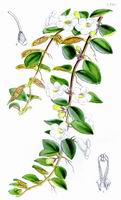
|
Codonanthe carnosa (Gardner) Hanst., fide A. Chautems Bot. Mag. t. 4531 (1850), as Codonanthe gracilis |
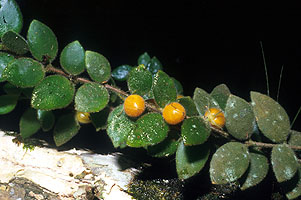
|
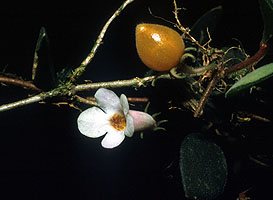
|
Codonanthe devosiana Lem.
Left: habit, fruiting plant |
last modified: 2007-07-13